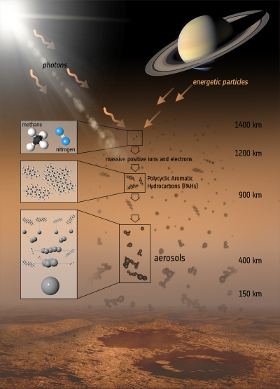Science highlights from Huygens:
#7. Titan's tiny aerosols
One set of measurements was made by the Gas Chromatograph and Mass Spectrometer (GCMS) and the Aerosol Collector and Pyrolyser (ACP) experiment. The collected aerosol particles were heated in the ACP oven in order to vaporise all volatile components, and the composition of the gases released by each sample was then analysed by the GCMS.
 |
| How aerosols form in Titan's haze. Credit: ESA / ATG medialab |
Two atmospheric samples were obtained during the descent of Huygens. One was taken at 130-35 km (the middle stratosphere) and the other at 25-20 km (the middle troposphere). Ammonia (NH3) and hydrogen cyanide (HCN) were identified as the main gases released in the oven, confirming that carbon and nitrogen are major constituents of the aerosols.
No substantial difference was found between the two samples, suggesting that the aerosols' composition was the same at both altitudes. This supports the idea that they have a common source in the upper atmosphere, where ultraviolet sunlight photochemically alters gases such as methane.
Meanwhile, the Descent Imager/Spectral Radiometer (DISR) characterised the optical properties of the photochemical aerosols from 150 km altitude to the surface. They were found to match the properties of 'tholins', materials created in laboratories by sending electrical discharges into mixtures of nitrogen and methane.
The aerosols' optical properties can be reproduced by the condensation of hydrogen cyanide close to 80 km, ethane condensation close to the tropopause (44 km), and methane condensation from the tropopause down to 8 km.




